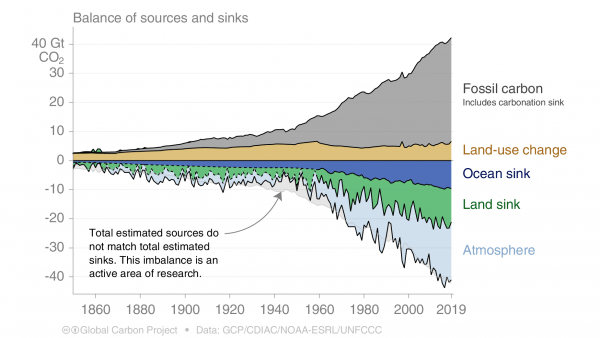GEOG Researchers Contribute to Global Carbon Budget 2020
GEOG researchers Louise Chini, George Hurtt, and Ben Poulter co-authored the “Global Carbon Budget 2020”, published recently in the journal Earth System Science Data. Drs. Chini and Hurtt provided global land-use data and Dr. Poulter provided estimates of land carbon uptake for this study, which has been produced annually by the Global Carbon Project since 2006 to report the current state of global CO2 fluxes and atmospheric concentrations. The Global Carbon Project is an international research project within the Future Earth research initiative on global sustainability, and a research partner of the World Climate Research Programme. It aims to develop a complete picture of the global carbon cycle, including both its biophysical and human dimensions together with the interactions and feedbacks between them.
The data provided by GEOG researchers for the Global Carbon Budget 2020 contributed to the research findings that emissions from land-use changes in 2020 were below 2019 levels and similar to the previous decade at about 6 billion tonnes of CO2. This amount is made up of 16 billion tonnes of CO2 emissions, primarily from deforestation, and just under 11 billion tonnes of CO2 removals, primarily from the vegetation regrowth due to from abandonment of agricultural lands. Land-use change emissions continue to rise predominantly from tropical regions, with substantial contributions from all continents (Latin America, Sub-Saharan Africa, Southeast Asia). Total CO2 emissions from human activities (from fossil CO2 and land-use change) are set to be around 40 billion tonnes of CO2 in 2020, compared to 43 billion tonnes of CO2 in 2019.
The abstract for the “Global Carbon Budget 2020” is provided below:
Accurate assessment of anthropogenic carbon dioxide (CO2) emissions and their redistribution among the atmosphere, ocean, and terrestrial biosphere in a changing climate – the “global carbon budget” – is important to better understand the global carbon cycle, support the development of climate policies, and project future climate change. Here we describe and synthesize data sets and methodology to quantify the five major components of the global carbon budget and their uncertainties. Fossil CO2 emissions (EFOS) are based on energy statistics and cement production data, while emissions from land-use change (ELUC), mainly deforestation, are based on land use and land-use change data and bookkeeping models. Atmospheric CO2 concentration is measured directly and its growth rate (GATM) is computed from the annual changes in concentration. The ocean CO2 sink (SOCEAN) and terrestrial CO2 sink (SLAND) are estimated with global process models constrained by observations. The resulting carbon budget imbalance (BIM), the difference between the estimated total emissions and the estimated changes in the atmosphere, ocean, and terrestrial biosphere, is a measure of imperfect data and understanding of the contemporary carbon cycle. All uncertainties are reported as ±1σ. For the last decade available (2010–2019), EFOS was 9.6 ± 0.5 GtC yr−1 excluding the cement carbonation sink (9.4 ± 0.5 GtC yr−1 when the cement carbonation sink is included), and ELUC was 1.6 ± 0.7 GtC yr−1. For the same decade, GATM was 5.1 ± 0.02 GtC yr−1 (2.4 ± 0.01 ppm yr−1), SOCEAN 2.5 ± 0.6 GtC yr−1, and SLAND 3.4 ± 0.9 GtC yr−1, with a budget imbalance BIM of −0.1 GtC yr−1 indicating a near balance between estimated sources and sinks over the last decade. For the year 2019 alone, the growth in EFOS was only about 0.1 % with fossil emissions increasing to 9.9 ± 0.5 GtC yr−1 excluding the cement carbonation sink (9.7 ± 0.5 GtC yr−1 when cement carbonation sink is included), and ELUC was 1.8 ± 0.7 GtC yr−1, for total anthropogenic CO2 emissions of 11.5 ± 0.9 GtC yr−1 (42.2 ± 3.3 GtCO2). Also for 2019, GATM was 5.4 ± 0.2 GtC yr−1 (2.5 ± 0.1 ppm yr−1), SOCEAN was 2.6 ± 0.6 GtC yr−1, and SLAND was 3.1 ± 1.2 GtC yr−1, with a BIM of 0.3 GtC. The global atmospheric CO2 concentration reached 409.85 ± 0.1 ppm averaged over 2019. Preliminary data for 2020, accounting for the COVID-19-induced changes in emissions, suggest a decrease in EFOS relative to 2019 of about −7 % (median estimate) based on individual estimates from four studies of −6 %, −7 %, −7 % (−3 % to −11 %), and −13 %. Overall, the mean and trend in the components of the global carbon budget are consistently estimated over the period 1959–2019, but discrepancies of up to 1 GtC yr−1 persist for the representation of semi-decadal variability in CO2 fluxes. Comparison of estimates from diverse approaches and observations shows (1) no consensus in the mean and trend in land-use change emissions over the last decade, (2) a persistent low agreement between the different methods on the magnitude of the land CO2 flux in the northern extra-tropics, and (3) an apparent discrepancy between the different methods for the ocean sink outside the tropics, particularly in the Southern Ocean. This living data update documents changes in the methods and data sets used in this new global carbon budget and the progress in understanding of the global carbon cycle compared with previous publications of this data set (Friedlingstein et al., 2019; Le Quéré et al., 2018b, a, 2016, 2015b, a, 2014, 2013). The data presented in this work are available at https://doi.org/10.18160/gcp-2020 (Friedlingstein et al., 2020).
Published on Tue, 12/15/2020 - 09:56


